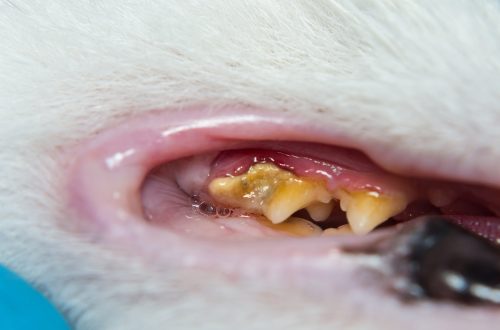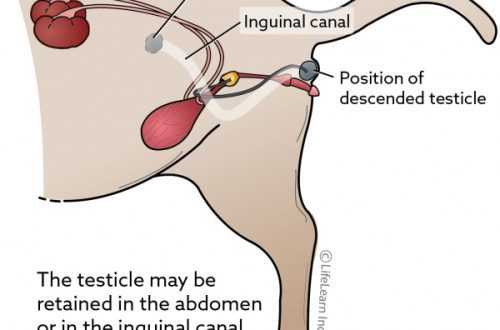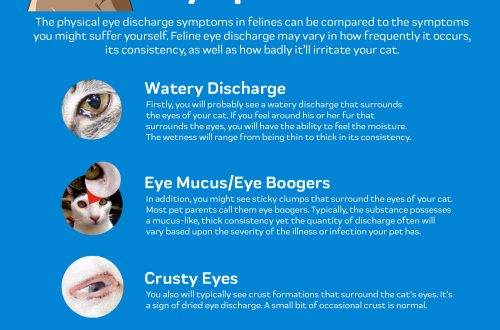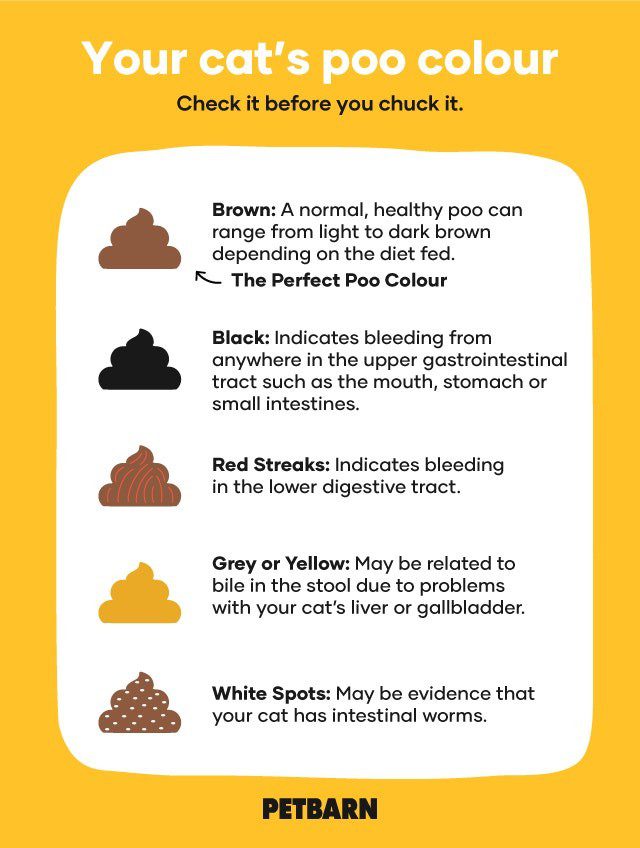
Why does a cat have white feces – 8 causes and treatment
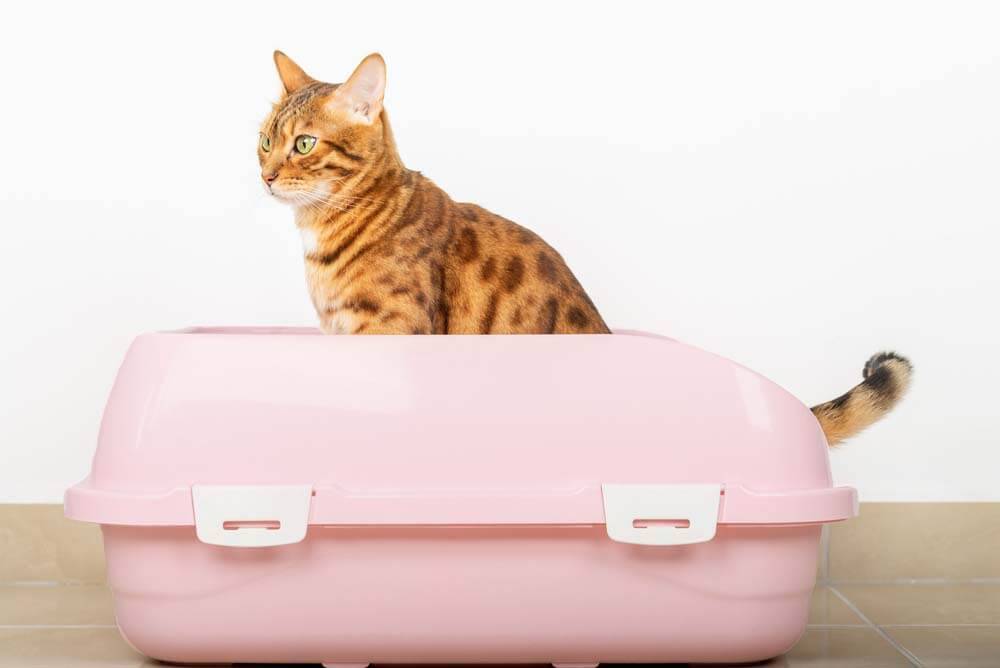
Contents
Causes of light stool in cats
Most often, the normal color of feces in cats is represented by different shades of brown. In the intestines, food is digested, including with the help of bile, as a result of which the substance stercobelin is formed. It gives the feces a brown tint.
The color of the stool sometimes simply reflects the characteristics of what was eaten. If the food contains a large amount of dyes – pigments or a lot of indigestible inclusions – this will invariably affect the contents of the tray.
White feces in a cat may be the result of a diet, but there are a number of pathologies, including quite dangerous ones, in which such changes are observed.
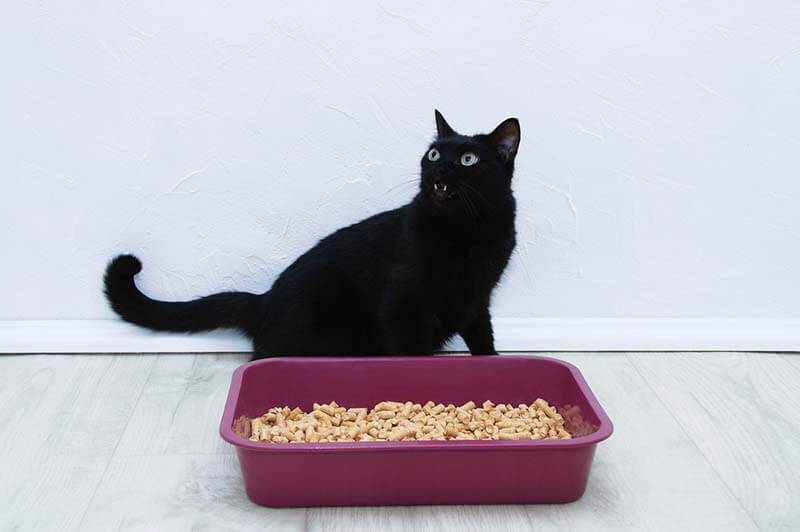
Non-dangerous reasons
Dairy produce
An excess of dairy products in the diet often leads to fermentation processes in the gastrointestinal tract (GIT), especially in adult animals. As a result, the cat may have light-colored stools (yellowish to ocher), excessive gas, and diarrhea.
Fatty food
A large amount of fat in the diet will lead to steatorrhea – feces with a high content of undigested fat. This is due to the fact that bile and pancreatic enzymes are simply not enough to digest excess fat. In this case, the cat’s feces become light, oily, soft, and diarrhea may begin. When feeding fatty foods, the risk of developing pancreatitis is high.
Wool
The cat repeatedly licks itself with its tongue every day, taking care of the hair, and swallows a significant amount of it. Most often, hairballs come out of the stomach with vomiting or daily with feces in small quantities and are invisible.
But in rare cases, they can accumulate and get into the feces in large volumes. The feces will then be dry, dense, whitish, fibrous due to inclusions of wool. Sometimes there is mucus, which also makes the feces lighter, and blood inclusions due to damage to the intestinal mucosa.
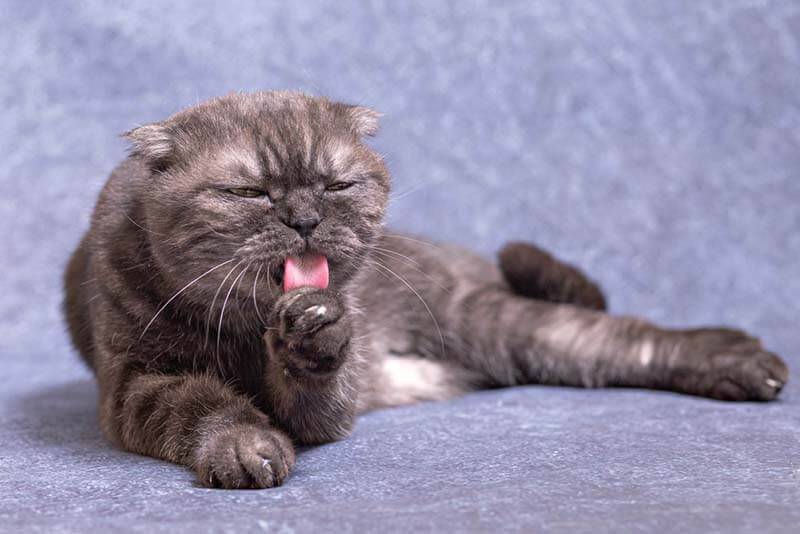
Dangerous reasons
Adding Bones to Your Diet
Spongy raw bones are able to be partially digested in the gastrointestinal tract, but most of them are excreted with feces. And if the diet consists of raw chicken necks or heads, then the cat will regularly have white poop.
Feces with inclusions of bone fragments are dry, crumbly, white. This reason is classified as dangerous, because the bones can damage the stomach and intestines, as well as get stuck in their lumen or walls, causing blockage, and sometimes perforation – through damage to the walls of the gastrointestinal tract.
Obstruction of the bile ducts
Bile enters the intestines from the liver through the bile ducts. Gallstones (choleliths), mucus, bile clots (sludges), parasites, and tumors can block the bile ducts. Also, a decrease in patency may be associated with swelling of the walls of the ducts due to inflammation. This is an extremely dangerous situation that requires immediate medical attention.
The feces of a cat in this case can be gray, clay, white. The consistency varies from thin to very dry and hard, especially if the animal is dehydrated due to vomiting or high fever.
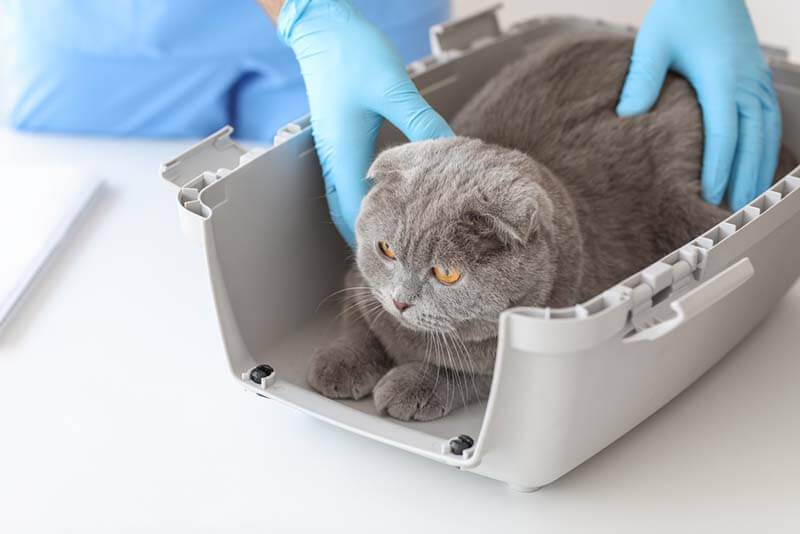
liver disease
With serious liver pathologies – hepatitis, cholangiohepatitis, lipidosis – the cat’s feces can also become gray or white.
This is due to the fact that liver cells cannot function properly during inflammation, and the bile ducts narrow or become blocked. Because of what, there is no normal production (formation) of bile and its outflow.
pancreatitis
The pancreas produces important enzymes, without which proper digestion is impossible. With inflammation, it cannot produce them in the right amount, and the cat’s feces will acquire a grayish, sometimes almost white hue due to undigested inclusions, including fat.
Bowel disease
Colitis or enterocolitis is an inflammation of only the large or large and small intestines. They are often accompanied by diarrhea and mucus in the feces.
There are many reasons for these diseases: protozoa, helminths, nutritional disorders, etc. Fecal masses move too quickly through the intestines due to inflammation, and are also covered with mucus, acquiring a whitish, grayish tint. Sometimes they can almost entirely consist of mucus.
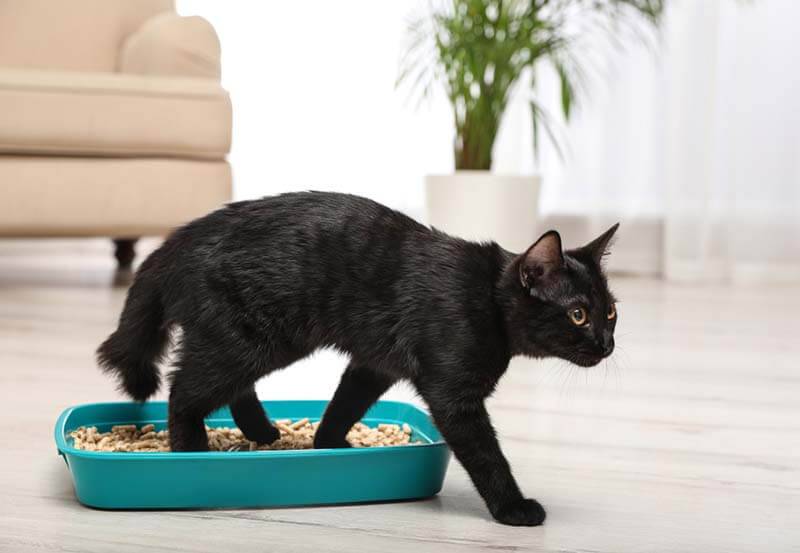
Possible additional symptoms
With diet errors, no additional symptoms are usually observed. Sometimes the stool can become very soft, even liquid. Increased gas production and more frequent bowel movements are also possible. After the diet is corrected, these symptoms disappear.
A large amount of wool in the stool can lead to constipation and the appearance of blood and mucus in the feces. At risk are long-haired breeds and breeds with a thick undercoat: Persian, Maine Coon, Exotic Shorthair, Highland Fold, British Shorthair, etc.
With obstruction of the biliary tract, in addition to white feces, the cat often develops jaundice: the skin and mucous membranes become yellow.
Also, the animal may have vomiting, diarrhea, abdominal pain, depression, refusal to feed and fever. The same symptoms will accompany liver disease.
With pancreatitis, abdominal pain can be very severe, the cat can hide, take a hunched posture with legs and tail tucked in. Also, pancreatitis is often accompanied by vomiting, diarrhea, refusal to feed.
Bone fragments in the diet not only make the cat’s feces white, but can also injure the intestines, leading to painful defecation. Sometimes the animal pushes hard and even meows when visiting the tray.
In colitis and enterocolitis, diarrhea and increased stool frequency are common symptoms. Sometimes the animal suffers from constant tenesmus – straining and the urge to defecate without result.
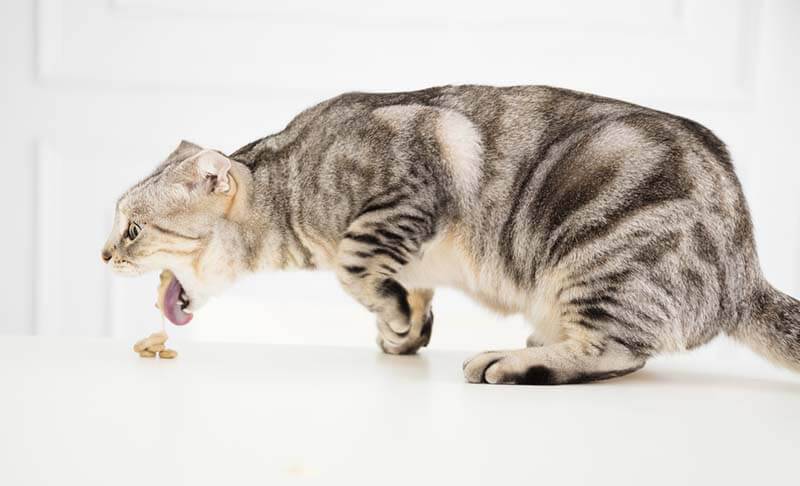
What can you do yourself?
When changing the color of feces, it is important to assess the condition of the cat. If it is good, the pet’s appetite and activity are not changed, then the probable cause is an error in the diet. It is worth evaluating it and adjusting it: for example, stop giving dairy, fatty foods, and bones in any form. In some cases, dietary deficiencies can lead not only to light-colored feces in a cat, but also to diarrhea. Sorbents will help to cope with it: Enterozoo, Smecta, Polysorb, Enterosgel.
It is helpful to regularly give your pet a de-hairing paste, especially cats with long or thick coats.
With colitis and enterocolitis, the general condition of the cat may remain good. However, it is important to consult a veterinarian to determine the cause of the pathology. Before contacting the clinic, you can give the cat sorbents and carry out treatment for helminths, especially if it has not been carried out for a long time.
If, in addition to white feces, the cat has other symptoms (decreased or no appetite, there are signs of pain, vomiting, diarrhea), then an immediate visit to the veterinary clinic is required.
Diagnosis of causes of white feces in cats
In most cases, your pet will have an abdominal ultrasound. It will help assess the condition of the liver, intestines, pancreas, as well as evaluate the gallbladder and the patency of the common bile duct.
In addition to ultrasound, general clinical and biochemical blood tests will be required. They will show the degree of inflammation, signs of anemia, abnormal liver function, signs of bile stasis – cholestasis.
If pancreatitis is suspected, a blood test for specific feline pancreatic lipase may be done. It helps to assess the degree of damage to the cells of the pancreas.
With colitis and enterocolitis, it may be necessary to examine feces for viruses, helminths, and protozoa.

Treatment
Liver diseases require complex treatment. The animal is replenished with fluid and electrolytes using infusions (droppers) with special solutions, nausea and vomiting are relieved. Antibiotics, gastroprotective and choleretic agents, vitamins of group B are often used.
Also, therapy may include: vitamin E, silymarin (milk thistle extract), L-carnitine.
In the case of lymphoplasmacytic cholangiohepatitis, steroids are used.
When there is suspicion of a complete blockage of the common bile duct, a diagnostic laparotomy is required, an operation that allows assessing and restoring its patency.
In the case of cholelithiasis – gallstones (rare in cats) – the gallbladder may need to be removed.
With pancreatitis, pain relief will be an important component of complex treatment, in addition to fluid replacement and antiemetic therapy.
In colitis and enterocolitis, antiparasitic agents are often required, for example, when helminths or protozoa are the cause of the pathology.
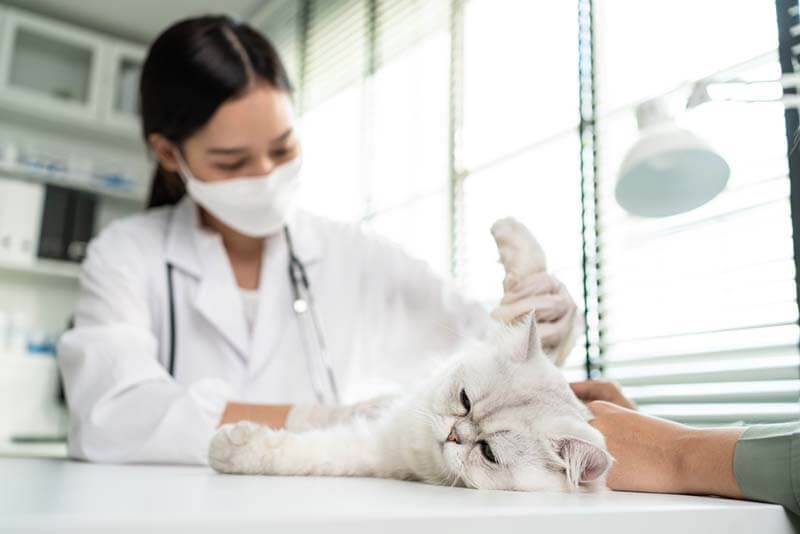
Diet
None of the considered pathologies provides for a starvation diet in cats, especially a long one. On the contrary, it can significantly worsen the condition.
Proper diet is an important part of treatment.
With liver diseases and pancreatitis, a cat needs a nutritious, but easily digestible food. The sooner the animal begins to receive food, the better.
Feeding is best to start with small portions of wet food, so it is absorbed easier and faster.
Sometimes, with severe liver disease, a cat may need prolonged force-feeding, and in this case it is more rational to put a special tube into the esophagus – an esophagostomy. This will help to establish a regular full feeding of the cat without the stress of force-feeding food.
With enterocolitis and colitis, an increased amount of fiber can be added to the feed. It helps to stop diarrhea, stabilizes peristalsis and is a substrate for beneficial bacteria in the intestines.
Kitten white stool
In kittens, discoloration of the feces will most often be associated with colitis, enterocolitis, or a violation of the diet. When feeding a kitten a large amount of dairy products, the stool becomes light. Sometimes foamy diarrhea can begin due to excess gas due to fermentation processes in the intestines.
Also, kittens can eat foreign objects, such as toilet filler. In this case, the feces will be dry, crumbly, whitish.
Colitis and enterocolitis in kittens are often caused by parasites: helminths and protozoa. With colitis, mucus in the feces can be present in very large quantities, completely covering them with a whitish coating. Sometimes a kitten poops only lumps or drops of mucus.
Pathologies associated with a violation of the production and outflow of bile are rare in kittens. However, they may have hepatitis, cholecystitis, and cholangiohepatitis. For example, as a complication of infections: panleukopenia, infectious peritonitis of cats, toxoplasmosis, viral leukemia, viral immunodeficiency.
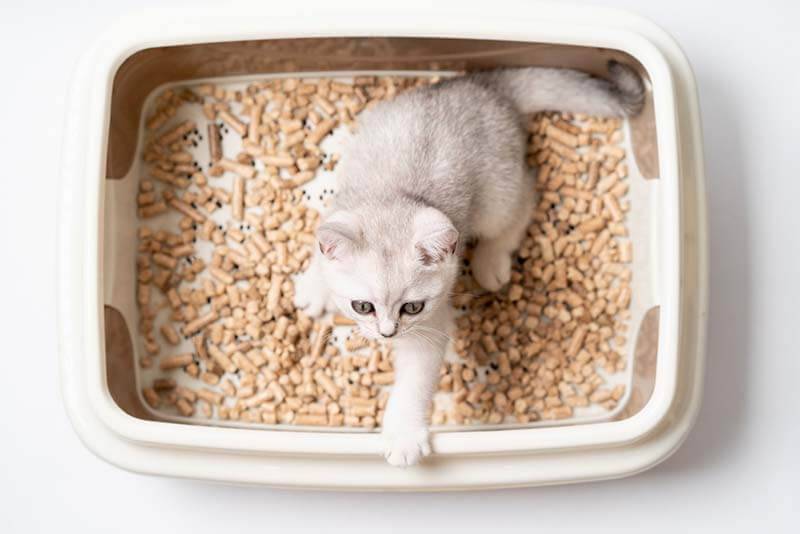
Light feces in cats – the main thing
It is important for the owner to pay attention to the color and consistency of the pet’s feces, as this is an important diagnostic feature.
The color of feces is determined primarily by the bile involved in digestion.
The diet can change the color of feces: partially digested bones, large amounts of dairy products, excess fiber, very fatty foods. If the cat’s light stool is not accompanied by any other symptoms, it is enough to evaluate the diet and, if necessary, adjust it.
A change in the color of feces can also be caused by foreign impurities: wool, filler.
Acholic (i.e., colorless, grayish, or white) feces can be a symptom of impaired bile production or flow, biliary obstruction, or liver disease. Also, feces can become lighter with pancreatitis, enterocolitis and colitis. In such cases, the pet will have other symptoms: vomiting, diarrhea, jaundice, fever.
Obstruction of the biliary tract, liver disease and pancreatitis require urgent diagnosis and complex treatment.
Answers to frequently asked questions
Sources:
Edited by Gary D. Norsworthy. The feline patient, fifth edition, 2018
Chandler E. A., Gaskell R. M., Gaskell K. J. Diseases of cats, 2011
KW Simpson. Pancreatitis and triaditis in cats. Review, 2016 // https://zooinform.ru/vete/articles/pankreatit_i_triadit_u_koshek_obzor/
E.D. Hall, D.V. Simpson, D.A. Williams. Gastroenterology of dogs and cats, 2010



